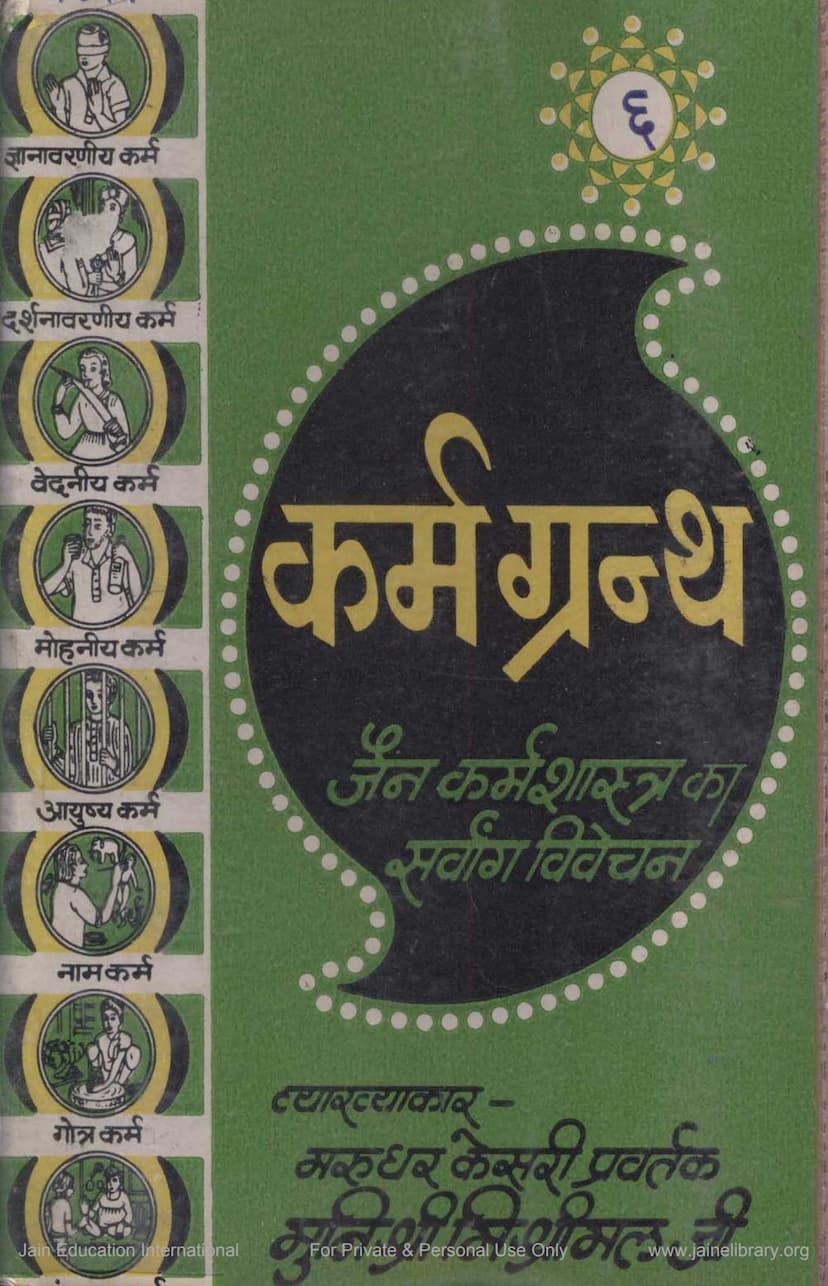Karmagrantha Part 6 Sapttika
Added to library: September 2, 2025

Summary
Here's a comprehensive summary of the provided Jain text, "Karmagrantha Part 6 Sapttika," based on the information and content presented:
Book Title: Karmagrantha Part 6 Sapttika (कर्मग्रन्थ भाग ६ सप्ततिका प्रकरण) Author(s): Devendrasuri (original author of the core Karmagrantha texts), Shreechand Surana, Devkumar Jain Shastri (commentators/editors of this specific edition) Publisher: Marudharkesari Sahitya Prakashan Samiti, Jodhpur Catalog Link: https://jainqq.org/explore/001897/1
Overview:
"Karmagrantha Part 6 Sapttika" is the sixth volume in a series dedicated to the "Karmagrantha," a foundational text in Jain philosophy. This particular volume, the "Sapttika Prakaran" (सप्ततिका प्रकरण), focuses on the intricate workings and classifications of karma, a central doctrine in Jainism. The book provides the original text (Mool), its word-for-word meaning (Shabdarth), verse-wise meaning (Gatharth), detailed explanations (Vishesharth), and further elaboration (Vivechan). It also includes a glossary of technical terms and other supplementary materials.
Core Jain Philosophy Presented:
The book centers around the Karmasiddhanta (कर्मसिद्धान्त), the doctrine of karma, which Jainism considers the key to understanding its entire philosophy. The text emphasizes that karma is the fundamental reason for the soul's (Atman) transmigration through the cycle of birth and death (samsara). Despite the soul's inherent purity and power, it is trapped in suffering and ignorance due to the influence of karma, which is described as subtle, material (pudgal), and binding.
The Karmagrantha Series and the Sapttika Prakaran:
The Karmagrantha itself is a significant work, comprising five parts by Shrimad Devendrasuri. These are:
- Karmavipaka (कर्मविपाक): Describes the fruition or consequences of karma and its various types.
- Karmastava (कर्मस्तव): Involves the praise of Tirthankaras and the description of the fourteen stages of spiritual progress (Gunsthanas) in relation to karma bondage and its manifestation.
- Bandhasvamatva (बंधस्वामित्व): Discusses karma bondage in relation to different realms of existence (Gati) and other classifications.
- Shadashiti (षडशीति): Elaborates on five key topics: Soul locations (Jivastan), stages of spiritual progress (Gunsthan), realms of existence (Marganasthan), states of being (Bhava), and numerical classifications (Sankhya).
- Shataka (शतक): Classifies karmic natures based on their permanence (Dhruv-bandhi, Adhruv-bandhi), persistence of their fruition (Dhruv-uday, Adhruv-uday), and analyzes their specific influx (Prakriti, Pradesh, Sthiti, Anubhag bandh) and their controllers, also detailing the stages of pacification (Upashamani) and destruction (Kshapaka).
The Sapttika Prakaran, the sixth Karmagrantha, is presented as the sixth in sequence, though its author is unknown. It derives its name from the 72 verses (Gathas) it contains. This volume systematically analyzes the binding (bandh), fruition (uday), and persistence (satta) of the eight fundamental karmas and their sub-categories. It uses the framework of soul-locations (Jivasthan), stages of spiritual progress (Gunsthan), and realms of existence (Marganasthan) to elucidate these concepts. The text also covers the processes of pacification (Upashamvidhi) and destruction (Kshapanvidhi) of karma.
Key Features of the Sapttika Prakaran and its Interpretation:
- Conciseness and Depth: The text is praised for its ability to condense vast and profound karmic principles into a relatively short volume, likened to filling the ocean into a pot.
- Authenticity: The first verse (Gatha 1) establishes the authenticity of the work by linking it to "Siddhapada" (सिद्धपद), referring to the scriptures of omniscient beings (Agam), and describing it as a condensed essence or droplet (Nisyanda) of the vast "Drishtivad Ang" (दृष्टिवाद अंग), the twelfth and most comprehensive Anga of Jain scripture. It also clarifies that the concepts of "Jivasthan" and "Gunsthan" are essential for understanding karma.
- Systematic Analysis: The book systematically details:
- Bandh, Uday, and Satta (बंध, उदय, सत्ता): The three primary states of karma.
- Bandh Sthan (बंधस्थान): The number of karmic natures that can be bound simultaneously.
- Uday Sthan (उदयस्थान): The number of karmic natures that manifest simultaneously.
- Satta Sthan (सत्तास्थान): The number of karmic natures that persist in the soul simultaneously.
- Sanvedh Bhang (संवेध भंग): The intricate combinations and variations of these states across different karmic types, soul-locations, and stages of spiritual progress.
- Extensive Detail: The text meticulously outlines the number of "bhangs" (variations/combinations) for each karma type across various Jivasthans and Gunsthans. This includes detailed analysis of:
- Jnanaavaran and Antaray Karma: Five types each.
- Darshanaavaran Karma: Nine types.
- Vedaniya Karma: Two types (pleasant and unpleasant).
- Ayush Karma: Four types (lifespan karma for different realms).
- Nam Karma: Ninety-three types.
- Gotra Karma: Two types (high and low status).
- Mohaniya Karma: Twenty-eight types, analyzed extensively through its various types of bandh, uday, and satta, and their permutations across gunsthans.
- Guidance from Ancient Commentaries: The Hindi commentary used for this edition relies on the work of Acharya Malayagiri's Vrutti (वृत्ति), a prominent commentator.
- Literary Style: The book is structured with the original verses, their literal meanings, explained meanings, deeper insights, and a comprehensive discussion, making it accessible to serious students of Jain philosophy.
Publisher and Editions:
The book is published by Shri Marudharkesari Sahitya Prakashan Samiti, Jodhpur. It is noted that this is the second edition, with the first edition published in 1976 (Veer Nirvana Samvat 2502) and the second in 1986 (Veer Nirvana Samvat 3515, Vikram Samvat 2046). The publication is dedicated to the birth centenary year of Gurudev Shri Marudhar Kesariji Maharaj.
Overall Significance:
"Karmagrantha Part 6 Sapttika" serves as a vital resource for understanding the Jain theory of karma, which is considered essential for the spiritual liberation of the soul. It systematically dissects the complex mechanisms of karma, providing a deep philosophical and practical insight into the Jain path to emancipation. The detailed analysis of how different karmic manifestations occur across various spiritual states and life forms makes it a comprehensive guide for scholars and sincere seekers of Jain wisdom.